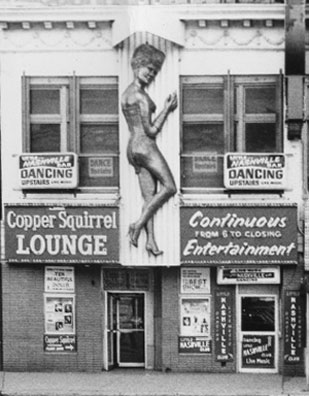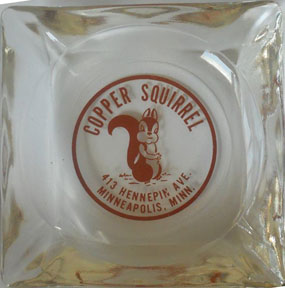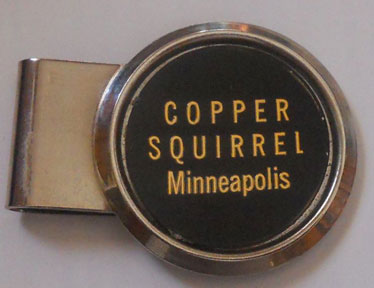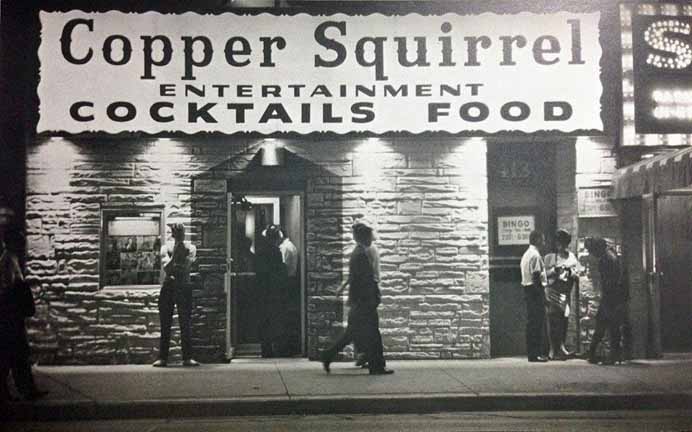Copper Squirrel
413 Hennepin Ave.
Minneapolis
This page concerns all of the businesses I could find at 413 Hennepin Ave., including a couple that were on the second floor. The building was erected in 1888 and divided into a store and a restaurant. Businesses in the 415 Hennepin side are on a separate page under the Saddle Bar.
NEW PALACE CAFE
James Tsiolis opened the New Palace Cafe on October 27, 1916. The place held 40 tables and could serve 150 customers. The Tribune waxed poetic:
Myriads of electric lights will make this place a Broadway drawing card to hundreds of famished pedestrians who will appease their hunger with substantial viands and delicacies as would tickle the palate of the most exacting connoisseur in gastronomy.
On May 2, 1930, it was announced that the New Palace Cafe faced bankruptcy because of unpaid debts. And indeed, its fixtures were advertised for sale that June.
PARAMOUNT CAFE
The next iteration was the Paramount Cafe, which opened in July 1930. It was apparently still owned by Tsiolis. On September 28, 1930, the Paramount had a serious fire, and a firefighter broke his back in the course of fighting the fire. Since two other properties belonging to Tsiolis had burned down and he had collected considerable insurance payoffs, he was dubbed “King Torch” in the press, and investigated heavily by the arson squad. In February 1937 he was found guilty of torching the Cafe.
JACK’S RESTAURANT/DOYLE’S CAFE
Jack Doyle ran a place alternately known as Jack’s Restaurant and Doyle’s Cafe, beginning in late December 1935. In January 1938 Doyle’s was the scene of a heroin deal. The perpetrators were William (Big Bill) Hildebrandt and Joe (Sixty) Katz.
On October 31, 1942, yet another spectacular fire occurred at the site. Spilled grease caught fire and lit up Hennepin Ave. This time one firefighter was killed and three were hurt during the two-hour battle to kill the flames.
In July 1945, Doyle’s was temporarily closed down as Jack was accused of running a gambling house. Interestingly, his lawyer was A.M. Cary, Attorney to the Mob. On July 21, 1945, the Tribune ran a banner headline, “Race Books Closed at Jack’s.”
“‘Cut it Out’ Warns Vice Squad Chief.” Jack’s was described as “one of the biggest, most notorious gambling spots in Minneapolis. Jack was urged to take a long vacation, and that the police department would not object if he stayed away permanently.
Jack’s rolled on, though, with items describing a wife throwing a brick through the window because her date wouldn’t pay the bill (July 1946).
The restaurant (open all night) was still called Jack’s in December 1948, but the operator was named as Arthur Berenson. The building was owned by Mrs. Mabel Bortz. On May 24 of that year, yet another fire killed a firefighter and injured three others.
PIT BAR-B-Q
In June 1959 Sam Polski leased the shop and ran a Pit Bar-B-Q busines until May of 1962. The place was prone to crime and prostitution, and in January 1963 Polski was ordered to show cause why it shouldn’t be shut down. Polski responded that he was going to closed on March 1, 1963. Fixtures were advertised for sale on March 31, 1963.
Meanwhile, the Gateway was being demolished, and the finite number of liquor licenses were up for grabs. The liquor license from the famed Persian Palms was transferred to the Pit Bar-B-Q in December 1962, but was not immediately used.
THE COPPER SQUIRREL
The Copper Squirrel was one of those old, venerable downtown bars that made Hennepin Ave. the hub of nightlife in the 1960s and ’70s. It was owned by Harry “Papa” Smull, described as an associate of Kid Cann (Minneapolis Star, November 19, 1975) who had owned the Persian Palms. At one time members of Smull’s family had owned seven liquor licenses, in violation of city ordinance. (Minneapolis Tribune, April 14, 1976).
The Copper Squirrel opened in August 1963. On September 13, Will Jones reported that the new place had
the old Persian Palms license, the old management, and for a week or so they had what looked like the same old dancing girls and lady MC working there. The only thing new was the address and the shining new wood and copper decor. But the old shows didn’t look right in the new setting, and the management nervously began shuffling acts. This week a Chicago coffeehouse comic was imported. He worked one night, was paid off for the week, and sent back to Chicago. Now they’ve brought in the Hank Hazlett Trio to swing a little, and it looks as though those three will stay awhile. And the show in the back room features Greta Gibson, Miss Sax Appeal, a tall, stacked blonde who blows everything from a Hungarian czardas to “Night Train” on a rackful of five saxophones…




Harry Smull died in April 1972 and the bar became the property of his estate.
SUN DISCO
By 1977 the Copper Squirrel had become a gay bar called the Sun Disco. (Minneapolis Star, November 16, 1977). In June 1981 it was described as the only drag bar in the Twin Cities.
DEMOLITION
NSP bought the building and the Andrews Hotel next door in August 1983. On January 15, 1984, dynamite made quick work of the buildings, flattening them in 7 seconds.
MORE UPSTAIRS
On August 2, the Squirrel opened More Upstairs, a jazz listening room located on the second floor of the building. The first combo was Ira Pettiford’s Trio. But as usual, jazz didn’t draw, and by December the room was presenting rock ‘n’ roll.
LITTLE NASHVILLE CLUB
In February 1969, More Upstairs was replaced with the Little Nashville Club, which was above both the Copper Squirrel and the adjacent Saddle Bar at 415 Hennepin. The address of the Little Nashville Club was given as 413 1/2 Hennepin. Johnnie White was one of the acts in 1969.


